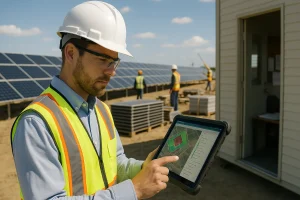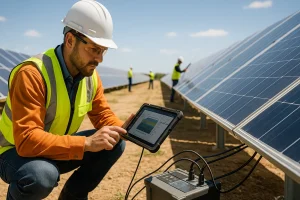Expert Solar Engineering: Future-Ready Design Solutions

Future-Ready Solar Design: How Expert Engineering Prepares For Tomorrow
The US solar industry faces unprecedented challenges in 2025. With policy uncertainty looming, supply chain volatility persisting, and interconnection delays plaguing utility-scale projects, solar installers and EPCs need robust engineering solutions now more than ever. Traditional reactive approaches simply won’t cut it when the US solar industry installed 10.8 gigawatts direct current (GWdc) of capacity in Q1 2025, a 7% decline from Q1 2024 despite strong demand. Expert solar engineering provides the strategic foundation needed to navigate these complexities while positioning your business for sustainable growth and operational excellence.
Advanced Solar Design Software: The Engineering Foundation
Modern solar projects demand precision that manual calculations can’t deliver. AI solar designs to EnergySage’s platform represent just the beginning of how expert engineering leverages cutting-edge tools to solve real-world problems.

Leading solar design platforms like Aurora Solar and PVcase have revolutionized how EPCs approach system optimization. These platforms integrate LIDAR data, 3D modeling, and AI-powered layout optimization to deliver designs that maximize energy production while minimizing installation costs. Aurora’s end-to-end capabilities, from AI-assisted panel placement to interactive sales proposals, make it the best solar design software in 2025 for most installers.
For utility-scale projects, specialized tools like RatedPower and HelioScope provide the engineering depth needed for complex grid integration studies and performance modeling. These platforms enable engineers to conduct detailed shading analysis, perform 8760-hour simulations, and generate bankable energy assessments that meet lender requirements.
Grid Integration Challenges and Engineering Solutions
The interconnection bottleneck represents one of the most significant barriers to solar deployment in 2025. interconnection challenges will remain a barrier to rapid utility-scale solar deployment in 2025. Despite state-level and regional reforms intended to expedite the queue process, multi-year backlogs remain pervasive.
Expert engineering teams anticipate these challenges by conducting thorough grid impact studies early in the development process. This proactive approach includes:
Power Flow Analysis: Comprehensive modeling of how new solar capacity will interact with existing grid infrastructure to identify potential voltage stability issues before they become costly problems.
Interconnection Planning: Strategic coordination with utilities and transmission operators to streamline the approval process and minimize delays.
Storage Integration: Pairing solar with battery energy storage systems to address grid stability concerns and improve project economics through peak-hour revenue capture.
Future-Ready System Design Methodologies
The rapid evolution of solar technology requires engineering approaches that can adapt to changing conditions. Advancements in photovoltaic (PV) technology continue to lead the evolution of the solar industry, making solar panels more efficient and less expensive.

Expert solar engineering incorporates future-proofing strategies such as:
Modular System Architecture: Designing systems with expansion capabilities to accommodate future capacity increases without major infrastructure overhauls.
Technology Agnostic Designs: Creating electrical and structural systems that can accommodate different panel technologies as efficiency improvements emerge.
Resilience Planning: Engineering systems to withstand extreme weather events and changing environmental conditions throughout their 25-year operational life.
Commercial and Utility-Scale Engineering Excellence
Large-scale solar projects require specialized engineering expertise that goes beyond residential installations. utility-scale solar has increased 44% year over year from 2023 to 2024, creating significant opportunities for EPCs with the right engineering capabilities.
Successful utility-scale engineering involves complex coordination between multiple disciplines:
Civil Engineering: Site preparation, grading optimization, and drainage design that minimizes environmental impact while maximizing usable land area.
Electrical Engineering: High-voltage system design, transformer selection, and protection coordination that ensures safe and reliable operation.
Structural Engineering: Racking system optimization for different terrain conditions and wind loading requirements.
Regulatory Compliance and Permitting Optimization
Navigating the complex regulatory landscape requires expert engineering that understands both technical requirements and local jurisdictional preferences. utility solar development is subject to stringent local, state, and federal regulations that can delay projects by months or even years.

Expert engineering teams maintain relationships with permitting authorities and stay current on evolving code requirements. This expertise translates into faster approvals and reduced project risk through:
Code Compliance Optimization: Designing systems that exceed minimum code requirements to facilitate smooth inspections.
Documentation Excellence: Providing comprehensive plan sets and technical specifications that address reviewer concerns proactively.
Local Expertise: Leveraging relationships with authorities having jurisdiction (AHJs) to streamline the approval process.
AI and Automation in Solar Engineering
The integration of artificial intelligence into solar engineering workflows represents a paradigm shift in how projects are designed and optimized. AI tools can create the most efficient designs in just minutes, considering all site-specific factors like location, energy goals, and roof space.
AI-powered engineering solutions deliver:
Automated Layout Optimization: Algorithms that test thousands of panel configurations to identify the optimal balance of energy production and installation cost.
Predictive Maintenance Planning: Machine learning models that anticipate component failures and optimize maintenance schedules.
Performance Forecasting: Advanced modeling that improves energy production estimates and reduces project risk.
Quality Assurance and Performance Validation
Expert solar engineering extends beyond initial design to encompass comprehensive quality assurance throughout the project lifecycle. This includes rigorous testing protocols, commissioning procedures, and performance validation that ensures systems meet or exceed design specifications.

Leading engineering firms implement systematic quality control processes including:
Design Review Protocols: Multi-stage review processes that catch potential issues before construction begins.
Field Verification: Regular site inspections during construction to ensure installation quality meets engineering specifications.
Performance Monitoring: Ongoing system monitoring and analysis to identify optimization opportunities and ensure long-term reliability.
Conclusion: Streamlining Engineering Excellence Through Integrated Solutions
The future of solar energy depends on engineering excellence paired with efficient project management. Both can navigate today’s challenges while positioning projects for long-term success. As market conditions continue to evolve, integrating expert engineering with streamlined project workflows becomes increasingly critical. This integration provides competitive advantage.
Energyscape Renewables delivers the expert engineering solutions that solar installers and EPCs need. These solutions help businesses thrive in 2025’s competitive market. Our comprehensive approach combines cutting-edge design tools, deep technical expertise, and proven project delivery methods. This ensures your solar projects exceed performance expectations while minimizing risk.
Whether you’re developing residential installations, commercial systems, or utility-scale facilities, expert solar engineering provides the foundation. This foundation supports sustainable business growth. To maximize the efficiency of your engineering excellence, effective project management becomes essential. Sunscape Solar offers specialized Solar Project Management Software and CRM solutions. These are designed specifically for solar businesses. They help you streamline workflows, manage client relationships, and coordinate teams effortlessly. This coordination spans from project planning through execution.

sjayakanth@energyscaperenewables.com